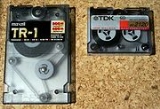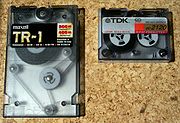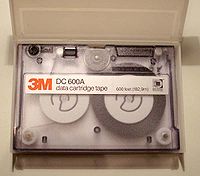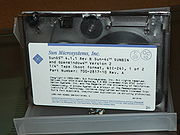
Quarter Inch Cartridge
Encyclopedia
Quarter inch cartridge tape (abbreviated QIC, commonly pronounced "quick") is a magnetic tape data storage
format introduced by 3M
in 1972, with derivatives still in use as of 2009. QIC comes in a rugged enclosed package of aluminum and plastic that holds two tape reels driven by a single belt in direct contact with the tape. The tape was originally 1/4 in wide and anywhere from 300 to 1500 ft (91.4 to 457.2 m) long. Data is written either linearily (mostly on pre-1980 equipment) or in serpentines. Since the introduction of the format, QIC has been widely used and many variations exist. There is a QIC trade association that publishes QIC standards which include interfaces and logical formats, to a very large extent it was the efficiency and openness of this organisation which encouraged hardware and software developers to use this type of drive and media.

where the tape is moved past the head by a capstan and pinch wheel, but the takeup reel is driven by a servo motor or slipping clutch.
The tape in a QIC cartridge is not physically attached to the reels and is never completely unwound. This is again different from other cassettes or cartridges, which generally have some form of clip anchoring on at least one end of the tape. To ensure that the tape is never completely unwound, each end has a small beginning or end of tape hole which is detected by an optical sensor, and an "early warning" hole further from each end. If a defective drive—for example with fluff in a sensor—winds the tape past the BOT or EOT marker, the tape will detach from the spool and the cartridge will be unusable unless it is reattached.
The design of the QIC tape cartridge is very robust: the aluminium baseplate is an eighth of an inch thick, and the robust plastic cover can withstand abuse and impacts that would damage other tape formats.
However, because the tape is belt-driven, seeking back and forth can eventually cause the tape to become unevenly tensioned. It is therefore necessary to periodically retension the cartridge. This is accomplished by winding the tape from beginning to end and back in one operation, allowing the belt to equalize itself. For newer QIC drives that use a SCSI
interface, there is a SCSI "RETENSION" command to do this.
When the cartridge gets old, the belt may not provide enough friction to turn the takeup spool smoothly. When this happens, the tape will need to be replaced.
In some cases a cartridge must be formatted before use. The capability to do this is in the drive rather than the host computer.

 The first QIC tape format was the 5.875 in by 3.875 in (150 x 99mm) Data Cartridge (DC) format with two internal belt-driven reels and a metal base. The original product, the DC300, had 300 feet of tape and held 200 kilobytes. Various QIC DC recording formats have appeared over the years, including:
The first QIC tape format was the 5.875 in by 3.875 in (150 x 99mm) Data Cartridge (DC) format with two internal belt-driven reels and a metal base. The original product, the DC300, had 300 feet of tape and held 200 kilobytes. Various QIC DC recording formats have appeared over the years, including:
Other QIC DC standards included the QIC-02 and QIC-36 drive interface standards. Later QIC DC drives usually used the SCSI
interface.
.
The QIC-40 and QIC-80 were designed to use the same controller
as a standard floppy drive, with MFM
or RLL
encoding.
is an evolution of the QIC Minicartridge format, sold for personal computer
use. This version, developed by 3M
, uses a longer and wider (8 mm) tape to give higher capacities.
is Tandberg Data
's name for its line of high-capacity QIC data cartridge drives. As of 2005, Tandberg was the only manufacturer of SLR/QIC drives in the world. The largest SLR drive can hold 70 GB of data (140 GB compressed).
that uses a wider .315 inch (8 mm) tape and increases the recording density. QIC-Wide drives are backwards compatible with QIC tapes.
, was made possible by making the cartridges physically longer to accommodate larger spools. In many cases a standard QIC drive and backup package can use the extended length to store additional data, however in some cases an attempt to reformat a QIC-EX cartridge fails since the time taken to traverse the extra length triggers a timeout in the drive or controlling software intended to detect a broken tape.
Magnetic tape data storage
Magnetic tape data storage uses digital recording on to magnetic tape to store digital information. Modern magnetic tape is most commonly packaged in cartridges and cassettes. The device that performs actual writing or reading of data is a tape drive...
format introduced by 3M
3M
3M Company , formerly known as the Minnesota Mining and Manufacturing Company, is an American multinational conglomerate corporation based in Maplewood, Minnesota, United States....
in 1972, with derivatives still in use as of 2009. QIC comes in a rugged enclosed package of aluminum and plastic that holds two tape reels driven by a single belt in direct contact with the tape. The tape was originally 1/4 in wide and anywhere from 300 to 1500 ft (91.4 to 457.2 m) long. Data is written either linearily (mostly on pre-1980 equipment) or in serpentines. Since the introduction of the format, QIC has been widely used and many variations exist. There is a QIC trade association that publishes QIC standards which include interfaces and logical formats, to a very large extent it was the efficiency and openness of this organisation which encouraged hardware and software developers to use this type of drive and media.

Features of QIC
The QIC cartridge is distinguished from other types of tape cartridges by the fact that it contains an endless drive belt which is moved at a uniform speed by a motorised capstan. Since the belt is in contact with the tape, this ensures both that the tape moves at uniform speed, and that neutral tension is maintained at all times. This is in contrast to cassette tapes or DATsDigital Audio Tape
Digital Audio Tape is a signal recording and playback medium developed by Sony and introduced in 1987. In appearance it is similar to a compact audio cassette, using 4 mm magnetic tape enclosed in a protective shell, but is roughly half the size at 73 mm × 54 mm × 10.5 mm. As...
where the tape is moved past the head by a capstan and pinch wheel, but the takeup reel is driven by a servo motor or slipping clutch.
The tape in a QIC cartridge is not physically attached to the reels and is never completely unwound. This is again different from other cassettes or cartridges, which generally have some form of clip anchoring on at least one end of the tape. To ensure that the tape is never completely unwound, each end has a small beginning or end of tape hole which is detected by an optical sensor, and an "early warning" hole further from each end. If a defective drive—for example with fluff in a sensor—winds the tape past the BOT or EOT marker, the tape will detach from the spool and the cartridge will be unusable unless it is reattached.
The design of the QIC tape cartridge is very robust: the aluminium baseplate is an eighth of an inch thick, and the robust plastic cover can withstand abuse and impacts that would damage other tape formats.
However, because the tape is belt-driven, seeking back and forth can eventually cause the tape to become unevenly tensioned. It is therefore necessary to periodically retension the cartridge. This is accomplished by winding the tape from beginning to end and back in one operation, allowing the belt to equalize itself. For newer QIC drives that use a SCSI
SCSI
Small Computer System Interface is a set of standards for physically connecting and transferring data between computers and peripheral devices. The SCSI standards define commands, protocols, and electrical and optical interfaces. SCSI is most commonly used for hard disks and tape drives, but it...
interface, there is a SCSI "RETENSION" command to do this.
When the cartridge gets old, the belt may not provide enough friction to turn the takeup spool smoothly. When this happens, the tape will need to be replaced.
In some cases a cartridge must be formatted before use. The capability to do this is in the drive rather than the host computer.
3M Data Cartridge (DC)


- QIC-11: a four-track format giving 20 MB on a 450 ft DC300XL cartridge
- QIC-24: nine-track, 45 MB or 60MB on a 450 or 600 ft (DC600A) cartridge respectively
- QIC-120: 15-track, 125 MB, DC6150 cartridge
- QIC-150: 18-track, 150 MB, DC6150 cartridge
- QIC-525: 26-track, 525 MB on a 1020 ft DC6525 cartridge
Other QIC DC standards included the QIC-02 and QIC-36 drive interface standards. Later QIC DC drives usually used the SCSI
SCSI
Small Computer System Interface is a set of standards for physically connecting and transferring data between computers and peripheral devices. The SCSI standards define commands, protocols, and electrical and optical interfaces. SCSI is most commonly used for hard disks and tape drives, but it...
interface.
QIC Mini Cartridge (MC)
Later, the smaller Minicartridge (MC) form-factor was introduced. This was 2.375 in by 3.125 in (61 x 80mm) size and was small enough to fit in a 3.5 in drive bayDrive bay
A drive bay is a standard-sized area for adding hardware to a computer. Most drive bays are fixed to the inside of a case, but some can be removed....
.
- QIC-40: 40 MB
- QIC-80: 80 MB
The QIC-40 and QIC-80 were designed to use the same controller
Controller (computing)
In computing and especially in computer hardware, controller is a chip, an expansion card, or a stand-alone device that interfaces with a peripheral device...
as a standard floppy drive, with MFM
Modified Frequency Modulation
Modified Frequency Modulation, commonly MFM, is a line coding scheme used to encode the actual data-bits on most floppy disk formats, hardware examples include Amiga, most CP/M machines as well as IBM PC compatibles. Early hard disk drives also used this coding.MFM is a modification to the original...
or RLL
Run Length Limited
Run length limited or RLL coding is a line coding technique that is used to send arbitrary data over a communications channel with bandwidth limits. This is used in both telecommunication and storage systems which move a medium past a fixed head. Specifically, RLL bounds the length of stretches ...
encoding.
Travan (TR)
TravanTravan
Travan is an 8 mm magnetic tape cartridge design developed by the 3M company, used for the storage of data in computer backups and mass storage. Over time, subsequent versions of Travan cartridges and drives have been developed that provide greater data capacity, while retaining the standard 8 mm...
is an evolution of the QIC Minicartridge format, sold for personal computer
Personal computer
A personal computer is any general-purpose computer whose size, capabilities, and original sales price make it useful for individuals, and which is intended to be operated directly by an end-user with no intervening computer operator...
use. This version, developed by 3M
3M
3M Company , formerly known as the Minnesota Mining and Manufacturing Company, is an American multinational conglomerate corporation based in Maplewood, Minnesota, United States....
, uses a longer and wider (8 mm) tape to give higher capacities.
| Format | Capacity (MB) | Speed (kB/s) | Tracks |
|---|---|---|---|
| QIC-80 | 80-500 | 62.5 | 28/36 |
| TR-1 | 400 | 62.5 | 36 |
| TR-1EX | 500 | 62.5 | 36 |
| QIC-3010 | 340 | 62.5 | 40/50 |
| TR-2 | 800 | 62.5 | 50 |
| QIC-3020 | 670 | 62.5 | 40/50 |
| TR-3 | 1,600 | 125 | 50 |
| TR-3EX | 2,200 | 125 | 50 |
| QIC-3080 | 1,200-1,600 | 125 | 60/72 |
| TR-4 | 4,000 | 1024 | 72 |
| QIC-3095 | 4,000 | 1024 | 72 |
| TR-5 | 10,000 | 1024 | 108 |
SLR
SLRScalable Linear Recording
Scalable Linear Recording is the name used by Tandberg Data for its line of QIC based tape drives.The earliest SLR drive, the SLR1, has a capacity of 250 MB, while the latest drive, the SLR140, has a capacity of 70 GB...
is Tandberg Data
Tandberg Data
Tandberg Data GmbH is a company focused on data storage products, especially streamers, headquartered in Dortmund, Germany. They are the only company still selling drives that use the QIC and VXA formats, but also produce LTO along with autoloaders, tape libraries, NAS devices, RDX Removable Disk...
's name for its line of high-capacity QIC data cartridge drives. As of 2005, Tandberg was the only manufacturer of SLR/QIC drives in the world. The largest SLR drive can hold 70 GB of data (140 GB compressed).
QIC-Wide
A variant from SonySony
, commonly referred to as Sony, is a Japanese multinational conglomerate corporation headquartered in Minato, Tokyo, Japan and the world's fifth largest media conglomerate measured by revenues....
that uses a wider .315 inch (8 mm) tape and increases the recording density. QIC-Wide drives are backwards compatible with QIC tapes.
QIC-EX
QIC Extra, a modification to support longer tapes and thus more data by the Verbatim CorporationVerbatim Corporation
Verbatim Americas, LLC is a US company that markets storage media and flash memory products. It is a subsidiary of Mitsubishi Chemical Holdings Corporation of Japan and is based in Charlotte, North Carolina.-History:...
, was made possible by making the cartridges physically longer to accommodate larger spools. In many cases a standard QIC drive and backup package can use the extended length to store additional data, however in some cases an attempt to reformat a QIC-EX cartridge fails since the time taken to traverse the extra length triggers a timeout in the drive or controlling software intended to detect a broken tape.

